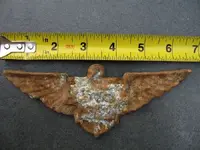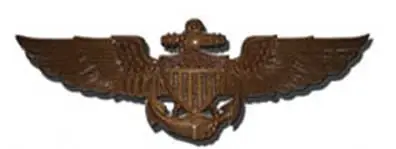Re: Winged What's It
NHbenz said:
Good movie, but back to reality most of us are seeing a variation of a naval aviator's badge, plaque size: photo borrowed from
www.plaquesandpatches.com/wings.htm
good one. HS-5 on the badge from what I can read:
HS-5=Helicopter Anti-Submarine Squadron five "the Nightdippers"
Helicopter Anti-Submarine Squadron FIVE [HELASRON HS-5]
"Nightdippers"
As of 2003, HS-5 was scheduled to be redesignated Helicopter Sea Combat Wing HSC-5 in February of 2009. This change reflected the switch to the MH-60S Knighthawk and the merger of Helicopter Tactical Wing, Atlantic Fleet [HELTACWINGLANT] and Helicopter Anti-Submarine Wing, Atlantic Fleet [HSWINGLANT] into Helicopter Sea Combat Wing, Atlantic Fleet [HELSEACOMBATWINGLANT].
HS-5 is a member of Carrier Airwing SEVEN (CVW-7) assigned to USS Dwight D. Eisenhower (CVN-69). The NIGHTDIPPERS fly two variations of the H-60 "Seahawk" helicopter, designated the HH-60H and SH-60F. The HH-60H's primary mission is combat search and rescue, naval special warfare support and anti-surface warfare. The SH-60F's primary mission is anti-submarine warfare (ASW) defense of the inner zone, which includes detection, classification and destruction of hostile submarines. Secondary missions are combat search and rescue (CSAR) and naval special warfare (NSW). Additional missions performed by both helicopters are logistic support, vertical replenishment (VERTREP), anti-surface warfare (ASUW) and medical evacuation (MEDEVAC).
Helicopter Antisubmarine Squadron FIVE was commissioned at Naval Air Station, Key West, Florida, on 3 January 1956. It's primary mission then was the same as today: To deny the enemy effective use of their submarines. From the very beginning HS-5 has been a pioneer in helicopter antisubmarine warfare (ASW). The squadron was the first to be fully equipped with 14 HSS-1 "Sea Horse" helicopters. In 1958, HS-5 received the first HSS-1N helicopter. Subsequent testing and evaluation proved that helicopters could be hovered at night over water without visual reference to the ocean and were ready for around-the-clock, all-weather ASW operations. It was due to this trailblazing effort with the submersible sonar-equipped HSS-1N that HS-5 acquired the name "NIGHTDIPPERS". Following a homeport move in 1959 to Naval Air Station, Quonset Point, Rhode Island, HS-5 was assigned to Carrier Antisubmarine Air Group FIFTY-FOUR. While assigned to CVSG-54, the squadron deployed several times on ASW exercises, participated in two Mercury spacecraft recoveries, and served as a member of the U.S. Quarantine Force during the Cuban Missile Crisis.
In 1963, HS-5 transitioned to the first twin jet-turbine helicopter, the SH-3A "Sea King". The next several years found HS-5 again deploying on numerous occasions for ASW exercises and astronaut recovery missions. The squadron surpassed 25,000 consecutive mishap free hours in 1968 and was presented with the Sikorsky Safety Award in recognition of this accomplishment. In 1969, HS-5 completed the transition to the SH-3D model helicopter, which had more powerful engines, greater endurance, and improved dipping sonar. In 1971, HS-5 earned the Atlantic Fleet Battle Efficiency "E" and the Captain Arnold Jay Isbell Trophy for ASW excellence.
In 1972, the NIGHTDIPPERS earned the Meritorious Unit Commendation for their participation in the rescue efforts near Elmira, New York, following Hurricane Agnes. Later that year, the squadron was permanently assigned to Carrier Air Wing SEVEN (CVW-7), embarked in USS INDEPENDENCE (CV 62). During the next four years, HS-5 made four extended deployments to the Mediterranean and changed its homeport to Naval Air Station, Jacksonville, Florida.
In 1978, HS-5 and CVW-7 were assigned to USS DWIGHT D. EISNEHOWER (CVN 69), then the Navy's newest nuclear powered aircraft carrier. Following an extended Mediterranean deployment, HS-5 transitioned to the SH-3H, which incorporated the latest in ASW technological advances. In 1980, HS-5 completed an arduous Indian Ocean deployment, spending 315 days that year deployed, including an unprecedented 157 consecutive days at sea. In 1981 and 1982, HS-5 deployed once to the North Atlantic Ocean and twice to the Mediterranean Sea, earning the Battle Efficiency Award. In 1983, the NIGHTDIPPERS completed another deployment to the Mediterranean, which included an at-sea period of 93 days. The squadron flew in excess of 3,000 hours in support of the EISENHOWER Battle Group and the multi-national Force in Beirut, Lebanon, and was twice awarded the CVW-7 Silver Wrench Award for maintenance excellence.
In 1985, HS-5 deployed to the Mediterranean and the Caribbean. Some of the major milestones completed were achieving over five years of mishap free flying, winning the first two competitions for the HSWING Commodore's Trophy for ASW Excellence, the Silver Anchor Award for retention, and the CNO Safety Award. In 1986, HS-5 conducted an extended turnaround training schedule involving operations on four aircraft carriers, USS Coral Sea (CV 43), USS SARATOGA (CV 60), USS NIMITZ (CVN 68), and USS THEODORE ROOSEVELT (CVN 71).
An extensive work-up cycle prepared HS-5 and the USS EISENHOWER for a 1988 Mediterranean deployment. The addition of a seventh helicopter embarked in USS PETERSON (DD 969) was the first ever six month detachment of a single SH-3H for ASW. The venerable "Sea King" again proved its mettle during numerous multi-national exercises and sensitive Black Sea operations. Well-recognized in 1988, the squadron reveled its fourth Captain Arnold Jay Isbell Trophy, sixth CNO Safely Award, and a Meritorious Unit Commendation.
Following a successful turnaround cycle highlighted by two successive HSWING ONE Maintenance Trophies, HS-5 deployed to the Mediterranean Sea in March 1990 aboard USS EISENHOWER. Referred to as the "Centennial Cruise" in honor of the 100th anniversary of the birth of President Dwight D. Eisenhower, this deployment included an unusual mid-deployment journey to the English Channel for participation in ceremonies in remembrance of the D-Day invasion of Normandy. In August, USS EISENHOWER left the Mediterranean again, transiting the Suez Canal and taking position in the Red Sea to deter possible Iraqi aggression against Saudi Arabia at the beginning of Operation DESERT SHIELD. The squadron proved the versatility of the SH-3H by removing ASW equipment and adding counter-targeting devises for use against possible missile threats. HS-5 was awarded its third Meritorious Unit Commendation after returning to Jacksonville in September 1990. In October, the Commander, Naval Air Forces Atlantic Fleet Performance Improvement Team cited the NIGHTDIPPER maintenance team as the best in the Atlantic Fleet.
Soon after returning from Operation DESERT SHIELD, the squadron converted to SLEP (Service Life Extension Program) aircraft. These revitalized SH-3H's were stripped, reworked, and fitted with many airframe improvements and more powerful turboshaft engines. During the turnaround cycle, HS-5 was awarded the CNO Safety Award. In October 1991, the squadron deployed to the Red Sea, Indian Ocean, and the Arabian Gulf aboard USS EISENHOWER, affording the NIGHTDIPPERS an opportunity to develop tactics and procedures for use in mine countermeasure and Combat Search and Rescue (CSAR) missions. Extensive operational evaluation with night vision goggles and various joint exercises with U.S. Air Force and regional allies were indicative of the changing operational atmosphere.
In March 1992, the squadron outchopped the Mediterranean Sea and transited north to participate in NATO Exercise TEAMWORK '92, returning to Jacksonville in April 1992. It was awarded the HSWING ONE Maintenance Trophy for the second half of 1991 and performed flawlessly on its post-deployment corrosion inspection.
In July 1992, HS-5 and CVW-7 were assigned to USS GEORGE WASHINGTON (CVN 73) and deployed for the "GW's" initial shakedown cruise during September and October. The squadron's commitment to excellence was recognized by its receiving the 1992 COMNAVAIRLANT Battle "E" Award, and DOD Maintenance Excellence awards. In May 1994, HS-5 deployed with USS GEORGE WASHINGTON (CVN 73) on her maiden deployment to the Mediterranean Sea. The NIGHTDIPPERS participated in the Fiftieth Anniversary of the D-Day invasion, supported Operations DENY FLIGHT and SHARP GUARD in the Adriatic Sea. They transited through the Suez Canal to the Arabian Gulf twice, first to participate in Operation SOUTHERN WATCH and again to counter Iraqi aggression near the Kuwaiti border in Operation VIGILANT WARRIOR. During the deployment, HS-5 surpassed 14 years and 44,000 hours of mishap-free flying. The NIGHTDIPPERS returned to Jacksonville in November 1994. The NIGHTDIPPERS marked the end of an era when the last of their SH-3H "Sea King" helicopter was transferred from NAS Jacksonville in January 1995. Although the Sea Kings were older than the personnel maintaining them, several upgrades, modifications, and service life extensions kept the H-3 up-to-date with the latest technological advances in ASW, electronics, and power plants. The squadron kept their vintage helicopters aloft for a total of 108,661.2 hours and ready-to-launch around the clock for over three decades. The Sea Kings were flown to different parts of the country. One is proudly displayed at the Quonset Point Air Museum in Rhode Island.
January 1995 began a new chapter in NIGHTDIPPER history when the squadron transitioned to the H-60 "Seahawk". Faced with completing a demanding transition during a compressed thirteen-month turnaround cycle, the men of HS-5 completed its transition 3 months ahead of schedule and meeting every operational commitment during their predeployment work-up schedule, HS-5 added yet another facet to their repertoire of warfare missions. While detached to NAS Fallon, Nevada, the NIGHTDIPPERS perfected Combat Search and Rescue (CSAR) procedures in preparation for deployment.
In January 1996, the NIGHTDIPPERS once again embarked in USS GEORGE WASHINGTON (CVN 73) where they joined Carrier Air Wing SEVEN in supporting NATO's Operation DECISIVE ENDEAVOR. When world events required swift action the CVN-73/CVW-7 team transited through the Suez Canal and into the North Arabian Gulf in support of Operation SOUTHERN WATCH.
While in the Gulf, the NIGHTDIPPERS continued to expand their joint warfighting proficiency, conducting several exercises in the Undersea Warfare (USW), Surface Warfare (SUW), Helicopter Visit Board and Search (HVBS) and Combat Search and Rescue (CSAR) mission areas. These multi-national exercises were highlighted by the first-ever drop of a MK-50 torpedo outside U.S. territorial waters.
Their mission in the Arabian Gulf complete, HS-5 returned to the Mediterranean. The NIGHTDIPPERS participated in 5 multi-national USW exercises and multi-national CSAR exercises. An intense focus on real world training resulted in HS-5 amassing more than 198.5 hours of actual sonar contact time, much of it against non-U.S. submarines. The NIGHTDIPPERS returned to Jacksonville in July of 1996.
As a result of their first operational deployment with the new SH-60F/HH-60H, the NIGHTDIPPERS were awarded the COMNAVAIRLANT Battle "E", the Thach USW Excellence Award and the Commander SIXTH Fleet "Hook' em" Award for Undersea Warfare Excellence. The NIGHTDIPPERS were also nominated for the Captain Arnold Jay Isbell Trophy in recognition of superior USW performance. This operational achievement was based on solid maintenance excellence, which included both the CVW-7 Golden Wrench Award and two consecutive Commander Helicopter Antisubmarine Wing, U.S. Atlantic Fleet Maintenance Awards.
In late February 1998, the NIGHTDIPPERS deployed with CVW-7 in USS JOHN C. STENNIS (CVN 74) on her maiden voyage around the world from Norfolk, Virginia to San Diego, California. During the deployment, HS-5 spent over four months in the Arabian Gulf in support of Operation SOUTHERN WATCH and returned to Jacksonville, Florida in late August 1998.
http://www.globalsecurity.org/military/agency/navy/hs-5.htm






